Pashupatinath Temple
| Pashupatinath Temple पशुपतिनाथ मन्दिर | |
|---|---|
 Night view of Pashupatinath Temple | |
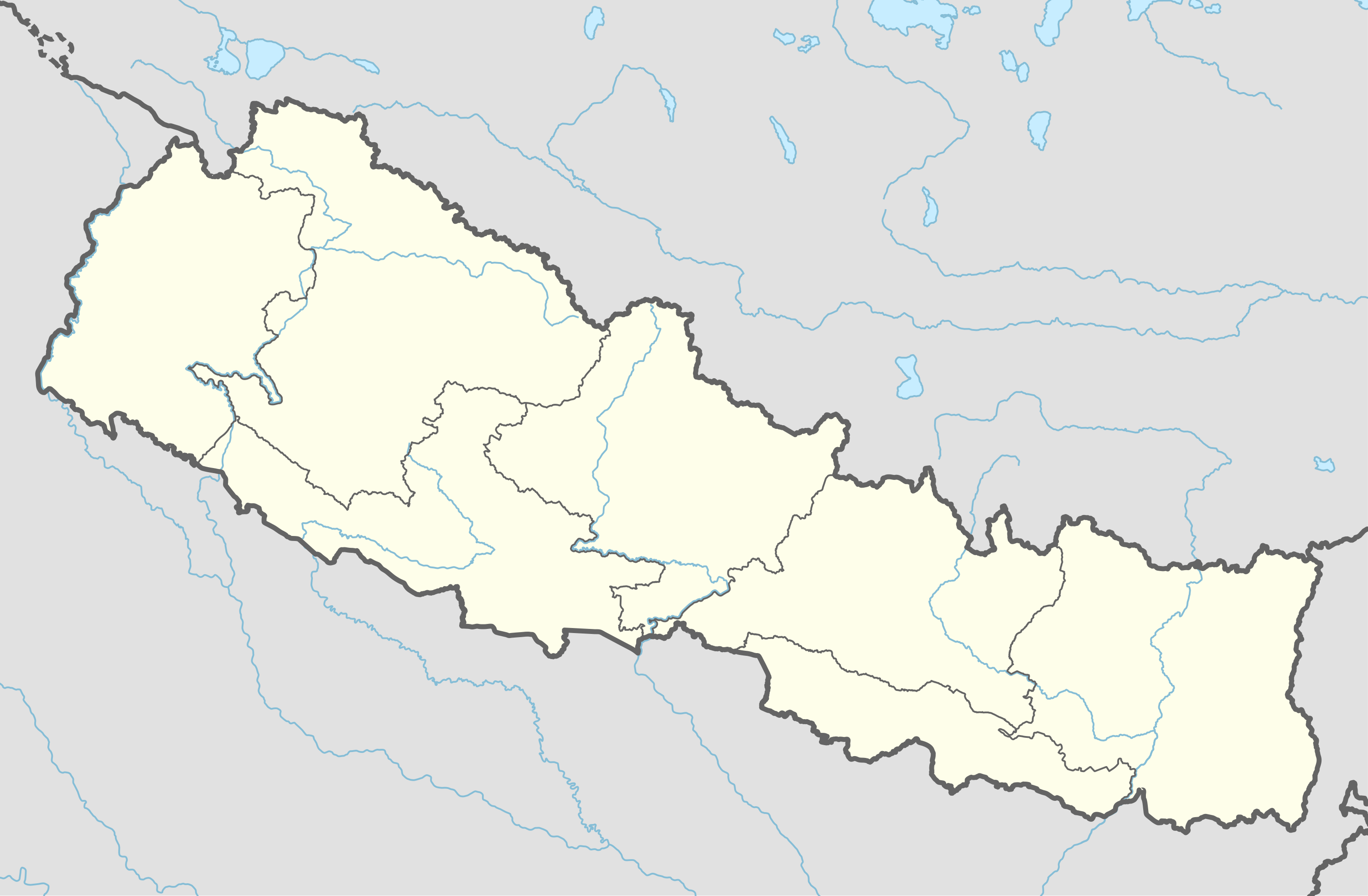 Location in Nepal | |
| Geography | |
| Coordinates | 27°42′35″N 85°20′55″E / 27.70972°N 85.34861°ECoordinates: 27°42′35″N 85°20′55″E / 27.70972°N 85.34861°E |
| Country | Nepal |
| Province | Province No. 3 |
| District | Kathmandu |
| Locale | Kathmandu |
| Culture | |
| Sanctum | Lord Shiva |
| Major festivals | Shivaratri, Teej, Bala Chaturdashi |
| Architecture | |
| Architecture | Pagoda |
| Number of temples | 492 |
| History | |
| Website | pashupati.org.np |

The Pashupatinath Temple (Nepali: पशुपतिनाथ मन्दिर) is a famous and sacred Hindu temple complex that is located on the banks of the Bagmati River, approximately 5 kilometres north-east of Kathmandu in the eastern part of Kathmandu Valley,[1] the capital of Nepal. The temple serves as the seat of Nepal’s national deity, Lord Pashupatinath. This temple complex was inscribed on the UNESCO World Heritage Sites's list in 1979.[2][3] This "extensive Hindu temple precinct" is a "sprawling collection of temples, ashrams, images and inscriptions raised over the centuries along the banks of the sacred Bagmati river" and is included as one of the seven monument groups in UNESCO's designation of Kathmandu Valley as a cultural heritage site.[4] One of the major Festivals of the temple is Maha Shivaratri on which day over 1 million devotees visit here.[5]
The twelve Jyotirlinga (in India) are the body and the Jyotirlinga at Pashupatinath in Kathmandu (Nepal) is the head over this body.
The temple is one of the 275 Tamil Paadal Petra Sthalams (Holy Abodes of Shiva) on the continent. Kotirudra Samhita, Chapter 11 on the Shivalingas of the North, in Shiva Purana mentions this Shivalinga as the bestower of all wishes.
History
The temple was erected anew in the 15th century by Lichhavi King Shupuspa after the previous building was consumed by termites.[6] Over time, countless further temples have been erected around this two -storied temple. These include the Vaishnava temple complex with a Rama temple from the 14th century and the Guhyeshwari Temple mentioned in an 11th-century manuscript.
Legend surrounding the origin of the temple
Pashupatinath Temple is the oldest Hindu temple in Kathmandu. It is not known for certain when Pashupatinath Temple was built. But according to Nepal Mahatmaya and Himvatkhanda,[7] the deity here gained great fame there as Pashupati, the Lord of all Pashus, which are living as well as non-living beings. Pashupatinath Temple's existence dates back to 400 B.C. The richly ornamented pagoda houses the sacred linga or holy symbol of Lord Shiva. There are many legends describing as to how the temple of Lord Aalok Pashupatinath came to existence here. Some of them are narrated below.
The Cow Legend
Legend says that Lord Shiva and Parvati once took the form of an antelope and sported unknown in the forest on the Bagmati river's east bank. The gods later caught up with him and grabbing him by one of his horns, forced him to resume his divine form. The broken horn was worshipped as a Sivalinga but over time it was buried and lost. Centuries later astonished herdsmen found one of his cows showering the earth with milk. Digging deep at the site, he discovered the divine linga of Pashupatinath.
The Lichchhavi Legend
According to Gopalraj Aalok Vamsavali, the oldest ever chronicle in Nepal, this temple was built by Supuspa Deva, a Lichchhavi King, who according to the stone inscription erected by Jayadeva 11 in the courtyard of Pashupatinath in 753 AD, happened to be the ruler 39 generations before Manadeva (464-505 AD).
The Devalaya Legend
Another chronicle states that Pashupatinath Temple was in the form of Linga shaped Devalaya before Supuspa Deva constructed a five-storey temple of Pashupatinath in this place. As the time passed, the need for repairing and renovating this temple arose. It is learnt that this temple was reconstructed by a medieval King named Shivadeva (1099-1126 AD). It was renovated by Ananta Malla adding a roof to it.[8][9] Thousands of pilgrims from all over the world come to pay homage to this temple, that is also known as 'The Temple of Living Beings'.
Other beliefs
There are several complex stories involving the origins of Pashupatinath. One story goes, in brief, that Shiva and Parvati came to the Kathmandu Valley and rested by the Bagmati while on a journey. Shiva was so impressed by its beauty and the surrounding forest that he and Parvati changed themselves into deer and walked into the forest. Many spots in the Kathmandu Valley have been identified as places where Shiva went during his time as a deer. After a while, the people and gods began to search for Shiva. Finally, after various complications, they found him in the forest, but he refused to leave. More complications ensued, but ultimately Lord Shiva announced that, since he had lived by the Bagmati river in a deer's form, he would now be known as Pashupatinath, Lord of all animals. It is said that whoever came here and beheld the lingam that appeared there would not be reborn as an animal.
Finding of Shiva Linga at Pashupatinath Temple
It is said that the wish-fulfilling cow Kamadhenu took shelter in a cave on the Chandravan mountain. Everyday Kamadhenu went down to the place the lingam was sunken into the soil and poured her milk on top of the soil. After a few thousand years some people saw Kamadhenu pouring milk on that same spot every day, and started to wonder what that would be. So they removed the soil and found the beautiful shining lingam and started worshiping it.
Temple complex
The area of Pashupatinath encompasses 264 hectares of land including 518 temples and monuments.[2] Main pagoda style temple is located in the fortified courtyard within the complex guarded by Semi-Military Nepal Police and Military Force Nepal Army and has a police outpost along with living quarter within. In front of the western door, there is a huge statue Nandi bull, in bronze. Along with many temples and shrines of both Vaishnav and saiva tradition.
Temples and Shrines in the inner courtyard
Temples and Shrines in the outer complex
- Ram mandir
- Virat swaroop temple
- 12 jyotirlingha and Pandra Shivalaya
- Guhyeshwari Temple
Main temple architecture
This main temple is built in the Nepalese pagoda style of architecture. All the features of pagoda style are found here like cubic constructions, beautifully carved wooden rafters on which they rest (tundal). The two level roofs are of copper with gold covering. The temple resides on a square base platform with a height of 23m 7 cm from base to pinnacle. It has four main doors, all covered with silver sheets. This temple has a gold pinnacle (Gajur). Inside are two Garbhagrihas, outer and inner. The inner garbhagriha or sanctum sanctorum is where the idol is placed and outer sanctum is an open corridor-like space.
The deity
The sacro sanctum, or the main idol is a stone Mukhalinga with a silver yoni base bound with the silver serpent. The lingam is one metre high and has faced in four directions. These faces represent various aspects of Shiva; Sadyojata (also known as Barun), Vamadeva (also known as Ardhanareshwara), Tatpurusha, Aghora & Ishana (imaginative). Facing West, North, East, South and Zenith respectively representing five primary elements namely earth, water, air, light and ether.[10] Each face has tiny protruding hands holding rudraksha mala on right hand and a kamandalu on the other. Unlike other Shiva lingams in India and Nepal this Pashupati Shiva lingam is always Dressed in its golden vastram except during abhisheka, so pouring milk and Ganga Jal is only possible during abhisheka through the main priests.
Priest

The unique feature of this temple is that only 4 priests can touch the idol. Daily rituals of Pashupatinath are carried out by two sets of priests ; one being the Bhatt priests and other Bhandari. Bhatta or Bhatt are the one who performs the daily ritual and can touch the lingam, whereas Bhandaris are the helper and temple caretaker priests who are not qualified to perform pooja rituals or to touch the deity.
Bhatta
Bhatta also spelt as Bhat are highly educated Vedic Dravida Brahmin Scholars from Karnataka. Unlike other Hindu temples, priesthood of Pashupatinath is not hereditary. Priests are selected from a group of scholars educated by Shri Shankaracharya Dakshinamnaya Peeth Sringeri on Rig Vedic Recitation, initiated in Pashupata Yoga by Kashi Math,Shiva Āgama and learned Recitation of Samaveda from Haridwar. After qualifying and fulfilling all those criteria they are selected for Priesthood by Raj Guru of Pashupatinath Temple undergoing strict examination on Vedas and Shiva Agamas and then the chosen priest is sent to Kathmandu for performing Puja and Daily Worship of Lord Shri Pashupatinath .
The unique feature of this temple is that only 4 Bhatta priests can touch the deity. Current Bhatt priests of the temple are;
Bhandaris
Also called Rajbhandari are the treasurers, temple caretakers, and assistant priest of the temple.[2] These Bhandaris are the descendants of helper priests brought up by early Bhatts, but were allowed to settle in Kathmandu valley and later assimilated in existing Newar caste of Rajbhandari - a high-caste Chathariya/Kshatriya clan of Kashyapa gotra. Their main function is to help the Bhatta priest and perform maintenance of the inner Garbhagriha. They can have little or no Vedic knowledge but still qualify as assistant priests if they belong from the same family lineage and undergo some basic criteria like caste, gotra, lineage purity, educational qualification, etc. They work in a set of three and change in every full moon day.[2] There are a total of 108 Bhandaris.
Entry and Darshan
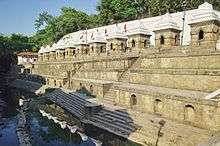
The temple courtyard has 4 entrances in the cardinal directions. The western entrance is the main entrance to the temple courtyard and the remaining three entrances are only opened during festival times. Temple security (Armed Police Force Nepal) and the Pashupatinath area development trust are selective regarding who is allowed entry into the inner courtyard. Practising Hindus and Buddhists of Nepali diaspora are only allowed into Temple courtyard. Practising Hindus of western descent are not allowed into the temple complex along with other non-Hindu Visitors with an exception to Sikh and Jain groups if they are of Indian ancestry. Others can look at the main temple from adjacent side of the river[12] and have to pay a nominal fee of $10 (1000 Nepali rupees) for visiting hundreds of small temples in the external premises of the temple complex. The inner temple courtyard remains open from 4 am to 7 pm for the devotee but the Inner Pashupatinath Temple where the Lingam of Lord Pashupatinath is established is open from 5 am to 12 pm for the morning ritual and viewing and from 5 pm to 7 pm for the evening ritual. Unlike many other Saiva temples, devotees are not allowed to enter in the inner-most Garbhagriha but are allowed to view from the exterior premises of the outer Garbhagriha.
Abhisheka
The inner sanctum where the Shiva Linga is placed, has four entrance, East, west, north, south. Normally devotees will have the Shiva Lingadarshan through western door entrance only. From 9:30 to 1:30 devotees can worship from all the 4 doors.
All the four doors are also opened during the Abhisheka time i.e. 9-11am. All the four sides of the Shiva Lingadarshan are possible during this period. One can take the abhisheka ticket at the SBI counter, available at the entrance of the temple. The basic abhisheka ticket costs around NPR.1100/-, which includes the Rudraabhisheka and various other poojas. Abhisheka will be done based on the direction the mukh is viewed. If your receipt says as eastern direction then one needs to stand in the queue at the eastern entrance, wherein the priests will do the abhisheka for the eastern mukh of the Shiva Linga.
Festivals
There are many festivals throughout the year and thousands of people attend these festivals. The most important festivals are the Maha Shiva Ratri Bala Chaturthi festival, and Teej festival. During these festivals, people from all over the world come to worship. [13]
Controversy of 2009
In January 2009, after the forced resignation by the chief priest of Pashupatinath temple, the Maoist-led government of Nepal "hand picked" Nepalese priests of Khas-Gorkhali ethnicity to lead the temple, thus bypassing the temple's long-standing requirements.[14] This appointment was contested by the Bhandaris of the temple, stating that they were not against the appointment of Nepalese priests but against the appointment without proper procedure.[2][15] After the appointment was challenged in a civil court, the appointment was overruled by Supreme Court of Nepal.[16][17] However, the government did not heed the ruling and stood by its decision. This led to public outrage and protests over a lack of transparency. The paramilitary group of the CPN (Maoist), called YCL, attacked the protesters, leading to over a dozen injuries.[18] Lawmakers and activists from opposition parties joined protests, declaring their support for the Bhatta and other pro-Bhatta protesters.[19] After long dissatisfaction and protest by Hindus both in and outside Nepal, the government was forced to reverse its decision that had been declared illegal by the Supreme Court of Nepal and reinstate Bhatta priests.
2015 earthquake
The main temple complex of Pashupatinath and the sanctum sanctorum was left untouched but some of the outer buildings in the World Heritage Site were damaged by the April 2015 Nepal earthquake.[20]
In popular culture
The buildings and street layout of the temple was used in the video game Commandos 2: Men of Courage in one stage of the game, "Target: Burma". Although the game was set in Burma, there were references to Gurkhas, soldiers of Nepali nationality.
Gallery
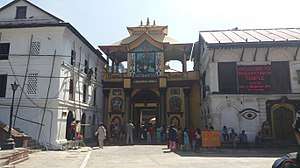

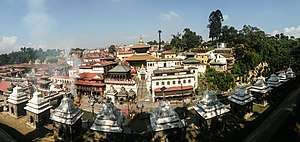


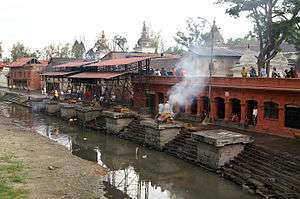

.jpg)
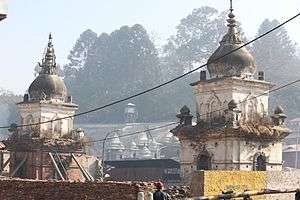

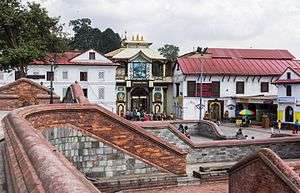
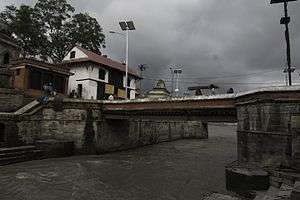
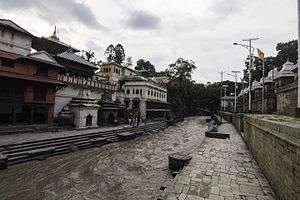
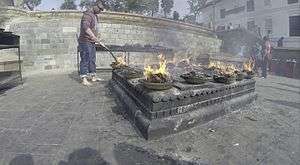
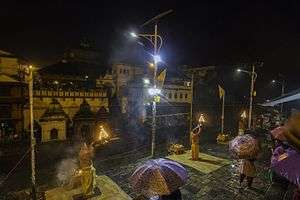
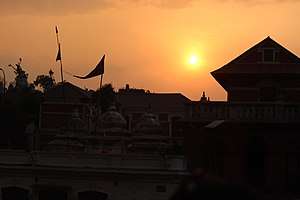
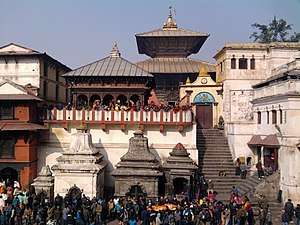

References
- ↑ "5th-century pashupatinath temple". 2014-08-02. Retrieved 2015-03-25.
- 1 2 3 4 5 "Hindu Shrine: Pashupatinath in Nepal". Newsblaze.com. 2009-01-08. Retrieved 2011-10-30.
- ↑ "SAARC tourism". Nepal.saarctourism.org. Retrieved 2011-10-30.
- ↑ "Kathmandu Valley". UNESCO. Retrieved 10 August 2014.
- ↑ "Pashupatinath Temple expects over 7 Lakhs Devotees on Mahashivratri". IANS. news.biharprabha.com. Retrieved 23 February 2014.
- ↑ Robertson McCarta and Nelles Verlag: Nelles Guide to Nepal, First Edition, 1990, page 94
- ↑ "Sacred destinations". Kathmandu, Nepal: Sacred destinations. 2009-05-05. Retrieved 2011-10-30.
- ↑ "Pashupatinath". Nepal.saarctourism.org. Retrieved 2014-08-05.
- ↑ "holy symbol". Mahashivratri.org. Retrieved 2014-08-05.
- ↑ Encyclopaedia of Saivism, Swami P. Anand, Swami Parmeshwaranand, Publisher Sarup & Sons, ISBN 8176254274, ISBN 9788176254274, page 206
- 1 2 3 4 5 "State's spiritual Kathmandu link". Deccanherald. Retrieved 2016-01-28.
- ↑ Mayhew, Bradley; Bindloss, Joe; Armington, Stan (2006). Nepal. Lonely Planet. p. 166. ISBN 978-1-74059-699-2.
- ↑ Nepal, Naturally. "Maha Shivaratri in Nepal". www.welcomenepal.com. Retrieved 2018-03-06.
- ↑ "Indian Express". Indian Express. 2009-01-05. Retrieved 2014-08-05.
- ↑ "Kantipur". Kantipuronline.com. Archived from the original on 2009-02-21. Retrieved 2011-10-30.
- ↑ "Sify". Sify. 2009-01-04. Retrieved 2011-10-30.
- ↑ "Kantipur". Kantipuronline.com. Archived from the original on 2009-02-22. Retrieved 2011-10-30.
- ↑ "Kantipur". Kantipuronline.com. Archived from the original on 2009-02-21. Retrieved 2011-10-30.
- ↑ "eKantipur". Kantipuronline.com. Archived from the original on 2009-02-21. Retrieved 2011-10-30.
- ↑ "holy symbol". economic times. Retrieved 2015-05-05.
External links
| Wikimedia Commons has media related to Pashupatinath temple. |



